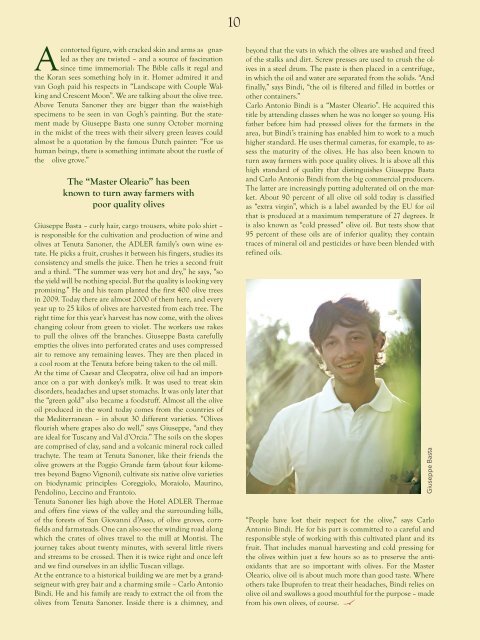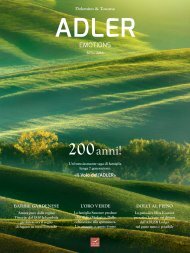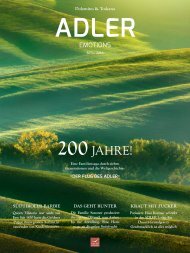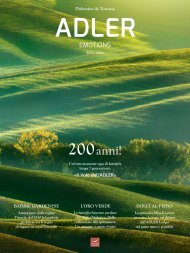You also want an ePaper? Increase the reach of your titles
YUMPU automatically turns print PDFs into web optimized ePapers that Google loves.
10<br />
A<br />
contorted figure, with cracked skin and arms as gnarled<br />
as they are twisted – and a source of fascination<br />
since time immemorial: The Bible calls it regal and<br />
the Koran sees something holy in it. Homer admired it and<br />
van Gogh paid his respects in “Landscape with Couple Walking<br />
and Crescent Moon”. We are talking about the olive tree.<br />
Above Tenuta Sanoner they are bigger than the waist-high<br />
specimens to be seen in van Gogh’s painting. But the statement<br />
made by Giuseppe Basta one sunny October morning<br />
in the midst of the trees with their silvery green leaves could<br />
almost be a quotation by the famous Dutch painter: “For us<br />
human beings, there is something intimate about the rustle of<br />
the olive grove.”<br />
The “Master Oleario” has been<br />
known to turn away farmers with<br />
poor quality olives<br />
Giuseppe Basta – curly hair, cargo trousers, white polo shirt –<br />
is responsible for the cultivation and production of wine and<br />
olives at Tenuta Sanoner, the <strong>ADLER</strong> family’s own wine estate.<br />
He picks a fruit, crushes it between his fingers, studies its<br />
consistency and smells the juice. Then he tries a second fruit<br />
and a third. “The summer was very hot and dry,” he says, “so<br />
the yield will be nothing special. But the quality is looking very<br />
promising.” He and his team planted the first 400 olive trees<br />
in 2009. Today there are almost 2000 of them here, and every<br />
year up to 25 kilos of olives are harvested from each tree. The<br />
right time for this year’s harvest has now come, with the olives<br />
changing colour from green to violet. The workers use rakes<br />
to pull the olives off the branches. Giuseppe Basta carefully<br />
empties the olives into perforated crates and uses compressed<br />
air to remove any remaining leaves. They are then placed in<br />
a cool room at the Tenuta before being taken to the oil mill.<br />
At the time of Caesar and Cleopatra, olive oil had an importance<br />
on a par with donkey’s milk. It was used to treat skin<br />
disorders, headaches and upset stomachs. It was only later that<br />
the “green gold” also became a foodstuff. Almost all the olive<br />
oil produced in the word today comes from the countries of<br />
the Mediterranean – in about 30 different varieties. “Olives<br />
flourish where grapes also do well,” says Giuseppe, “and they<br />
are ideal for Tuscany and Val d’Orcia.” The soils on the slopes<br />
are comprised of clay, sand and a volcanic mineral rock called<br />
trachyte. The team at Tenuta Sanoner, like their friends the<br />
olive growers at the Poggio Grande farm (about four kilometres<br />
beyond Bagno Vignoni), cultivate six native olive varieties<br />
on biodynamic principles: Coreggiolo, Moraiolo, Maurino,<br />
Pendolino, Leccino and Frantoio.<br />
Tenuta Sanoner lies high above the Hotel <strong>ADLER</strong> Thermae<br />
and offers fine views of the valley and the surrounding hills,<br />
of the forests of San Giovanni d’Asso, of olive groves, cornfields<br />
and farmsteads. One can also see the winding road along<br />
which the crates of olives travel to the mill at Montisi. The<br />
journey takes about twenty minutes, with several little rivers<br />
and streams to be crossed. Then it is twice right and once left<br />
and we find ourselves in an idyllic Tuscan village.<br />
At the entrance to a historical building we are met by a grandseigneur<br />
with grey hair and a charming smile – Carlo Antonio<br />
Bindi. He and his family are ready to extract the oil from the<br />
olives from Tenuta Sanoner. Inside there is a chimney, and<br />
beyond that the vats in which the olives are washed and freed<br />
of the stalks and dirt. Screw presses are used to crush the olives<br />
in a steel drum. The paste is then placed in a centrifuge,<br />
in which the oil and water are separated from the solids. “And<br />
finally,” says Bindi, “the oil is filtered and filled in bottles or<br />
other containers.”<br />
Carlo Antonio Bindi is a “Master Oleario”. He acquired this<br />
title by attending classes when he was no longer so young. His<br />
father before him had pressed olives for the farmers in the<br />
area, but Bindi’s training has enabled him to work to a much<br />
higher standard. He uses thermal cameras, for example, to assess<br />
the maturity of the olives. He has also been known to<br />
turn away farmers with poor quality olives. It is above all this<br />
high standard of quality that distinguishes Giuseppe Basta<br />
and Carlo Antonio Bindi from the big commercial producers.<br />
The latter are increasingly putting adulterated oil on the market.<br />
About 90 percent of all olive oil sold today is classified<br />
as “extra virgin”, which is a label awarded by the EU for oil<br />
that is produced at a maximum temperature of 27 degrees. It<br />
is also known as “cold pressed” olive oil. But tests show that<br />
95 percent of these oils are of inferior quality; they contain<br />
traces of mineral oil and pesticides or have been blended with<br />
refined oils.<br />
“People have lost their respect for the olive,” says Carlo<br />
Antonio Bindi. He for his part is committed to a careful and<br />
responsible style of working with this cultivated plant and its<br />
fruit. That includes manual harvesting and cold pressing for<br />
the olives within just a few hours so as to preserve the antioxidants<br />
that are so important with olives. For the Master<br />
Oleario, olive oil is about much more than good taste. Where<br />
others take Ibuprofen to treat their headaches, Bindi relies on<br />
olive oil and swallows a good mouthful for the purpose – made<br />
from his own olives, of course.<br />
Giuseppe Basta






